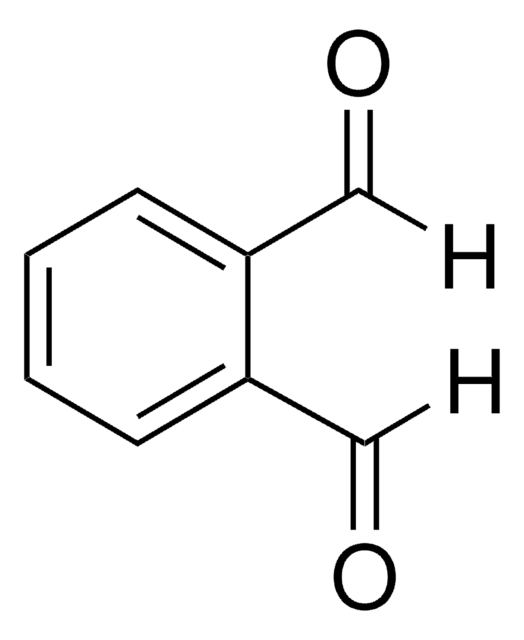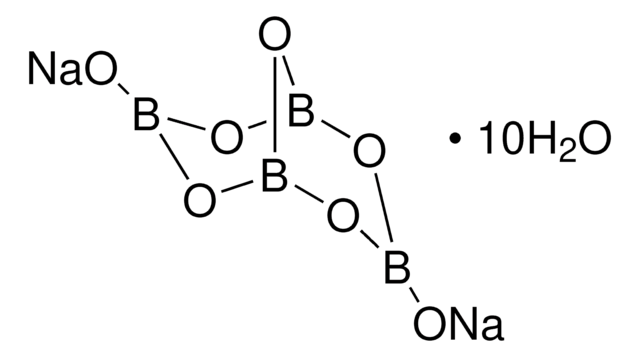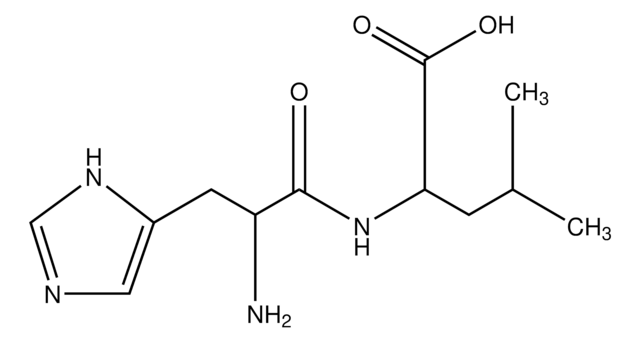Wichtige Dokumente
P1378
Phthaldialdehyd
≥97% (HPLC), powder or crystals
Synonym(e):
o-Phthalaldehyd, Benzol-1,2-Dicarboxaldehyd, OPA
About This Item
Empfohlene Produkte
Assay
≥97% (HPLC)
Form
powder or crystals
Farbe
white to light yellow
mp (Schmelzpunkt)
55-58 °C
Lagertemp.
2-8°C
SMILES String
O=Cc1ccccc1C=O
InChI
1S/C8H6O2/c9-5-7-3-1-2-4-8(7)6-10/h1-6H
InChIKey
ZWLUXSQADUDCSB-UHFFFAOYSA-N
Suchen Sie nach ähnlichen Produkten? Aufrufen Leitfaden zum Produktvergleich
Verwandte Kategorien
Anwendung
- für den Nachweis von Arg mittels Spektrophotometrie unter Verwendung von Endpunkt-Fluoreszenz-Sensitivitätsnachweis
- als Reagensstrom mit der Probe zum Erzeugen eines fluoreszierenden Produkts zum Bestimmen von Ammoniak in Meerwasser
- im o-Phthaldialdehyd-Spektrophotometrie-Assay (OPA-Test) zum Bestimmen der proteolytischen Aktivität (PA) der Stämme und im Handel erhältlichen Kulturen
Biochem./physiol. Wirkung
Signalwort
Danger
H-Sätze
Gefahreneinstufungen
Acute Tox. 3 Oral - Aquatic Acute 1 - Aquatic Chronic 1 - Eye Dam. 1 - Skin Corr. 1B - Skin Sens. 1 - STOT SE 3
Zielorgane
Respiratory system
Lagerklassenschlüssel
6.1A - Combustible acute toxic Cat. 1 and 2 / very toxic hazardous materials
WGK
WGK 3
Flammpunkt (°F)
269.6 °F - closed cup
Flammpunkt (°C)
132 °C - closed cup
Persönliche Schutzausrüstung
Faceshields, Gloves, Goggles, type ABEK (EN14387) respirator filter
Hier finden Sie alle aktuellen Versionen:
Besitzen Sie dieses Produkt bereits?
In der Dokumentenbibliothek finden Sie die Dokumentation zu den Produkten, die Sie kürzlich erworben haben.
Kunden haben sich ebenfalls angesehen
Unser Team von Wissenschaftlern verfügt über Erfahrung in allen Forschungsbereichen einschließlich Life Science, Materialwissenschaften, chemischer Synthese, Chromatographie, Analytik und vielen mehr..
Setzen Sie sich mit dem technischen Dienst in Verbindung.













